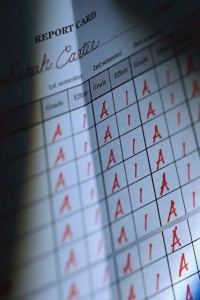 Let’s continue our look at report cards, which we started last week. Although students are given a letter grade based on the percentage earned from their assignments, tests, and quizzes, this letter grade is converted to a number for the purpose of calculating the GPA (grade point average). With this conversion, an “A” has the value 4.0, while an “F” has a value of 0.0. The full breakdown of values is as follows:
Let’s continue our look at report cards, which we started last week. Although students are given a letter grade based on the percentage earned from their assignments, tests, and quizzes, this letter grade is converted to a number for the purpose of calculating the GPA (grade point average). With this conversion, an “A” has the value 4.0, while an “F” has a value of 0.0. The full breakdown of values is as follows:
A+ (97%) – 4.0
A (93%) – 4.0
A– (90%) – 3.7 (3.67)
B+ (87%) – 3.3
B (83%) – 3.0
B– (80%) – 2.7 (2.67)
C+ (77%) – 2.3
C (73%) – 2.0
C– (70%) – 1.7 (1.67)
D+ (67%) – 1.33
D (63%) – 1.0
D– (60%) – 0.7 (0.67)
F – 0.0
With these values, then, it is easy to calculate a student’s GPA: a student who had three As, two Bs, and one C would have a GPA of 3.3:
three As: 4.0 X 3
two Bs: 3.0 X 2
one C: 2.0 X 1
20 points for 6 classes = 20/6 ==> 3.3
One of the drawbacks of calculating the GPA in this way is that an “A” in a relatively easy class (such as typing) is no different than an “A” in a more difficult class (such as calculus or physics). This means that some students would probably take classes that are easy, instead of classes that are more challenging, because they are trying to keep their GPA as high as possible. A solution to this is the concept of “weighted grades.” Weighted grades are used primarily at the high school level, but not all high schools use weighted grades.
Weighted grades take into account the level of difficulty of the particular subject. Harder subjects in general, or honors classes in particular, are worth more in terms of their GPA value than easy subjects / non-honors classes. So in a weighted-grade system, an “A” in calculus would have a GPA value of 5.0 (for example) instead of the normal 4.0. With weighted grades, then, it is possible to have a GPA that is higher than 4.0 (which is the maximum GPA under a non-weighted-grade system). Weighted grades help to reward the risk to a student’s GPA in taking more challenging classes.
Report cards used to be completed by hand, and the teacher would pass them out at the end of the term. The student would then be expected to take them home for the parents to look at (who had to sign them, indicating that they had seen the report card), and then bring them back to school. Of course, there were many students who were afraid to bring home their report cards (or pretended to “lose” or “forget” their report cards) because they were ashamed of their grades!
Nowadays, report cards are addressed to the parents and mailed to the student’s home. Not as many excuses for “lost” or “forgotten” report cards this way! Many schools also let parents log in and check their student’s grades at any time during the school term, as well as check for missing assignments, etc. If a parent has concerns about his student’s academic performance, he can also request a parent-teacher conference.
Next week we’ll wrap up this little series on report cards with a look at why GPAs are important to students.
